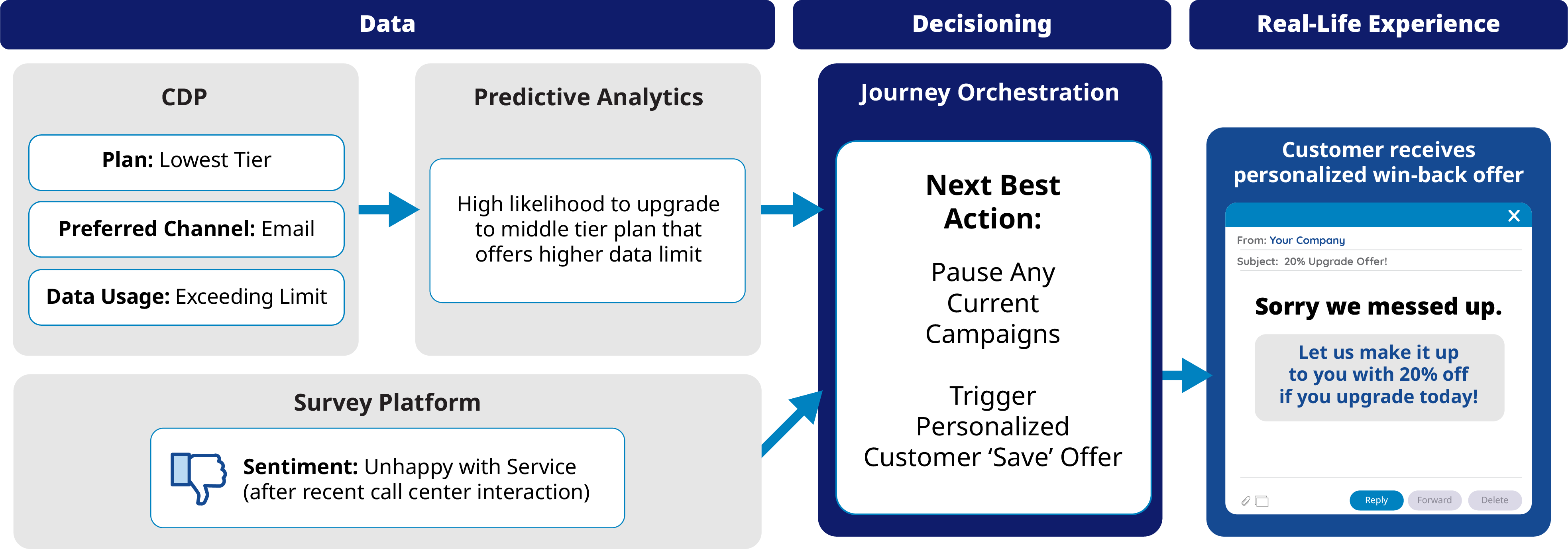As data has become increasingly valuable—by some metrics outvaluing oil—companies are finding themselves drowning in a sea of data so vast they’re overwhelmed by how to process it. The sheer volume can be far too great for traditional marketing departments to interpret and analyze without access to specialized software, blurring the lines between what the information technology (IT) and marketing departments do.
This newly created connection between marketing and IT often results in siloed processes, wherein the IT department independently gathers and interprets the data that teams like marketing, sales and customer experience (CX) need to access. There’s a name for this modern challenge companies are facing when looking to excel in the digital age: the data chasm.
The data chasm is the gap between a company’s data collection and analyzation processes and the effective use of that processed data across departments in a way that optimizes CX. This paradoxical scenario is becoming increasingly common in a digital-first world. How does that look in practice? Many companies find that despite gathering copious amounts of data, they struggle with how to best integrate that information into their operations.
Understanding the Data Chasm
Imagine you have all the pieces of a puzzle but lack the methodology to assemble them into a coherent picture. That’s precisely the dilemma when looking across the data chasm. Organizations possess robust data collection systems but often lack the vision or strategy to ensure that data is used effectively.
Data silos are one of the primary culprits behind the data chasm. Compartmentalization, or siloing, is prevalent in today’s rapidly evolving digital marketplace. That’s because when departments operate within disparate systems, it’s challenging to access and integrate data between teams that don’t traditionally work together. Consequently, customer insights become fragmented, hindering the company’s ability to deliver personalized CX.
The consequences of siloed data reverberate throughout the organization, impacting both CX and business outcomes. Customers are frustrated by disjointed interactions, which harms brand loyalty and tarnishes the company’s reputation.
Bridging the Data Chasm With Empathy
To traverse the data chasm successfully, companies must adopt an empathetic approach toward their customers. Understanding where disconnected systems frustrate customers is key to delivering exceptional CX. After all, in an era where CX is as crucial to customers as the company’s core services, empathy is a differentiating factor.
Empathy fosters a sense of being valued among customers, translating into heightened loyalty and advocacy. When customers feel understood and appreciated, they’re more likely to engage with the brand on a deeper level, driving long-term relationships.
Enter: Customer Journey Orchestration
One effective and attainable first step to navigating the data chasm is to implement software that helps your company orchestrate customer journeys. At its core, customer journey orchestration (CJO) is about harnessing the power of data to deliver seamless, personalized and secure experiences across every touchpoint.
Journey orchestration software serves as a central hub where disparate data sources converge, enabling companies to gain holistic insights into their customers’ journeys. Through integration, automation and analytics, journey orchestration transforms raw data into actionable insights, empowering organizations to make informed decisions that drive CX excellence.
At the heart of CJO lies the concept of actionable insights. Rather than allowing your marketing and sales teams to drown in data, journey orchestration software will help them identify the most pertinent information that drives meaningful outcomes. By focusing on the right data points, companies can tailor their strategies to effectively meet customers’ evolving needs.

Choosing the Right Journey Orchestration Software Provider
Selecting the right CJO software provider is crucial to bridging the data chasm. Here are some key considerations:
- Scalability and integration: Look for a solution that seamlessly integrates with existing systems and can scale according to your company’s growth trajectory.
- Ease of implementation: Prioritize user-friendly software that streamlines the implementation process, minimizing disruption to your operations.
- Vendor support: Assess the level of support and training programs offered by the provider to ensure your team can maximize the software’s capabilities.
- Industry expertise: Choose a provider with a deep understanding of your industry and proven experience in implementing AI-driven strategies.
In an era of relentless competition, future-proofing your CX is non-negotiable. By embracing CJO software, companies will bridge the data chasm and unlock unparalleled customer experiences. This isn’t just about staying ahead of the curve; it’s about setting new standards for CX excellence.
Ready to Take the Next Step to Improving CX?
CSG brings more than 40 years of industry experience (and customer empathy) to the journey orchestration process, helping you tailor offerings to what your customers want. Your company will drive customer experience-led growth with CSG’s industry-leading CJO platform, CSG Xponent.


